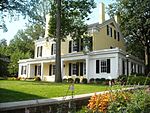Borough of Princeton, New Jersey

The Borough of Princeton was a borough of New Jersey that existed from 1813 until the end of 2012. On January 1, 2013, it merged Princeton Township to form Princeton, New Jersey; both the Borough of Princeton and Princeton Township were dissolved in the merger. The borough was located in Mercer County, in the U.S. state of New Jersey, and was completely surrounded by the former Princeton Township, from which it was formed in 1894. As of the 2010 United States census, the borough had a population of 12,307, reflecting a decline of 1,896 (-13.3%) from the 14,203 counted in the 2000 Census, which had in turn increased by 2,187 (+18.2%) from the 12,016 counted in the 1990 Census.The Borough of Princeton was incorporated by an act of the New Jersey Legislature on February 11, 1813, within portions of West Windsor Township (in what was then part of Middlesex County) and Montgomery Township (in Somerset County), and was reincorporated on November 27, 1822. The borough became part of the newly created Mercer County in 1838, and became a fully independent municipality circa 1894. Portions of territory were acquired from Princeton Township on January 4, 1928, and August 21, 1951. On November 8, 2011, voters in Princeton Borough voted to consolidate with Princeton Township.Morven, the former residence of the Governor of New Jersey, is at 55 Stockton Street in the former borough, while the current residence is Drumthwacket in the former township.
Excerpt from the Wikipedia article Borough of Princeton, New Jersey (License: CC BY-SA 3.0, Authors, Images).Borough of Princeton, New Jersey
Dohm Alley,
Geographical coordinates (GPS) Address Nearby Places Show on map
Geographical coordinates (GPS)
| Latitude | Longitude |
|---|---|
| N 40.350461 ° | E -74.659371 ° |
Address
Dohm Alley
08542
New Jersey, United States
Open on Google Maps










